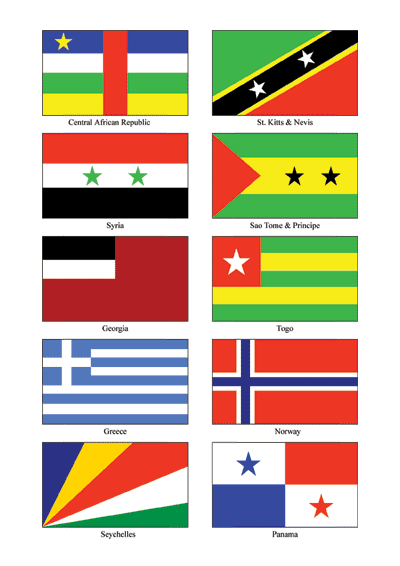
A larger PDF version can be downloaded from here.
<pdtanner@hum.nagoya-cu.ac.jp>
QUICK GUIDE
Key Words:Pairwork, giving instructions, asking clarification questions, imperative form
Learner English Level: Intermediate and higher
Learner Maturity Level: Junior high and above
Preparation Time: Less than one hour
Activity Time: One 90-minute class
Materials: Reproductions of flags from about 10 different countries, each on a B5 sheet of paper. National flags can be found online at www.imagesoft.net/flags/flags.html and www.countryreports.org/flags/.
This activity presents an interesting way to practice giving and receiving instructions using visual and directional vocabulary. An ancillary benefit is the knowledge learned about countries and their flags.
Draw, copy, or paste 8-10 different flags onto separate sheets of B5 paper. Copy enough flags so that each student will have four to five available. Although the flags could be done in color, I suggest making them black and white. Using black and white makes it easier to photocopy the flags.

A larger PDF version can be downloaded from here.
Step 1: Write key vocabulary on the board and ensure students understand these words: parallel, perpendicular, horizontal, vertical, diagonal, upper left, lower right, shade (verb), 6-point star, rectangle, square, triangle, equal, and divide.
Step 2: Ask students to explain how to draw the Japanese flag. Elicit responses, making sure that students use the imperative form, and draw the flag on the board. Next ask about a more complex flag that students know, such as the American flag. A step-by-step run-through helps them to realize how it can be done.
Step 3: Give each pair a copy of a flag and a blank sheet of B5 paper. One partner should explain how to draw the flag, and the other partner should listen and draw it. The partner who is drawing must not look at the flag being described. I allow the person giving instructions to look at the drawing being made. Start out with easy flags (such as Panama).
Step 4: When the student finishes drawing the flag, she or he can look at the original flag and compare. The partners return the original flag to the teacher, receive a new flag, and the partners switch roles. The new flag should be drawn on the back of the (formerly blank) B5 sheet of paper. Step 5: Give out new flags and blank sheets of paper as needed.
As students practice giving and receiving instructions and using the new vocabulary, they will improve and be able to draw flags faster and more accurately. As a wrap-up activity, the teacher could show the class the best flags and review the key grammar points and address any areas in which students had difficulty.
Further activities could include (a) a discussion of the geographical location of the countries used, (b) what the symbols of a flag represent, and (c) designing a flag for a newly independent country or redesigning Japan's flag.
A good sourcebook is
Ryan, S. (Ed.). (1999). Eyewitness handbooks: Flags. London and New York: Dorling Kindersley.